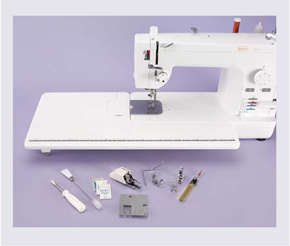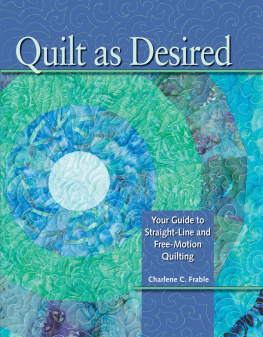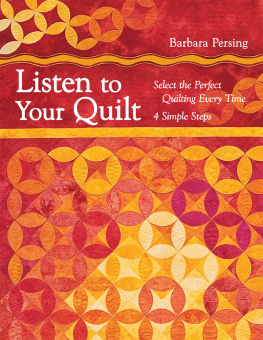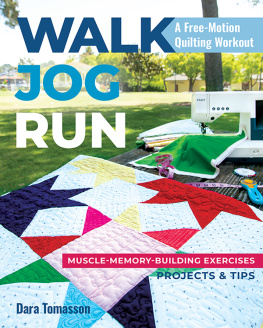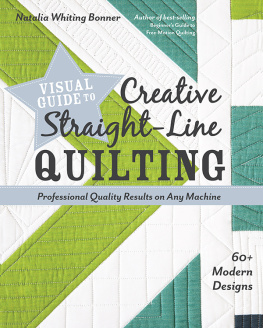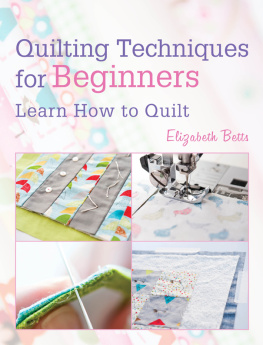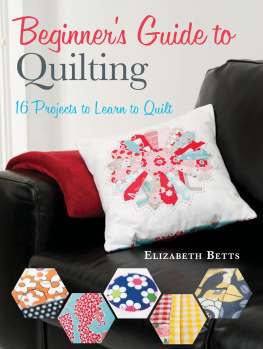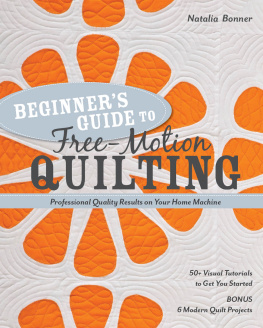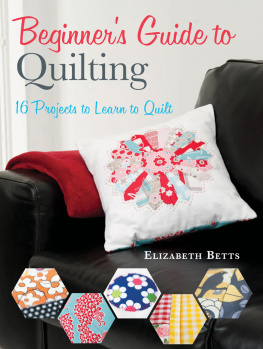Quilt as Desired
Charlene C. Frable

2007 Charlene C. Frable
Published by

Our toll-free number to place an order or obtain
a free catalog is (800) 258-0929.
All rights reserved. No portion of this publication may be reproduced or transmitted in any form or by any means, electronic or mechanical, including photocopy, recording, or any information storage and retrieval system, without permission in writing from the publisher, except by a reviewer who may quote brief passages in a critical article or review to be printed in a magazine or newspaper, or electronically transmitted on radio, television, or the Internet.
The following registered trademark terms and companies appear in this publication: Pfaff, Baby Lock, Quilter's Choice Professional, Free-Motion Slider, Sulky, Golden Threads, Schmetz, Madeira, Collins, Quilter's Choice, IDT, Omnigrid, Kwik Klip, YLI, Mettler
Library of Congress Catalog Number: 2006935548
ISBN-13: 978-0-89689-479-2
eISBN-13: 978-1-4402-2106-4
Edited by Andy Belmas
Designed by Heidi Bittner-Zastrow
Printed in China
Acknowledgments
I would like to thank the following individuals for helping to turn my dream into a reality:
My husband, Barry, who supports my every endeavor.
My parents, Bill and Sally Coleman, who encouraged me to pursue my passions in life.
To my sister, Phyllis Coleman Post, who took me to my first quilt show. Phyllis also pieced one of the quilts used in Section One.
To Diana Slopik, who steered my passion for quilting towards teaching.
To every quilter I have met through my classes. Your questions and your zeal to finish your own quilts have made me a better teacher. For that, I am grateful.
Baby Lock USA for the use of the Baby Lock Quilter's Choice Professional sewing machine for the photo shoot.
Pat LaPierre for her encouragement and LaPierre Studio for the Free Motion Slider.
Andy Belmas, the editor of this book. He is truly a patient man, and I am grateful for all the excellent suggestions he made along the way.
Candy Wiza, who is the most outgoing and approachable editor at Quilt Market.
Robert Best, who I found to be a great photographer and all around good guy.
All the staff at Krause Publications, thank you for your efforts on this project.
Introduction
I still remember completing my first quilt top in 1991. It was a small, wall-hanging sized quilt that I pieced by machine. I draped the quilt top over a chair, and then stared at the last page of the quilt instructions which read, Quilt as desired. I was in trouble. I had been sewing for 25 years, but I had no quilting experience. So I quilted it by machine, sewing straight lines without a walking foot. Disappointed, I packed the wall hanging away.
A year later, my sister made arrangements for us to attend an upcoming quilt show. At exactly 10:00 AM on the day of the quilt show, the doors opened to what would become my favorite sewing passion. I was stunned at how many quilts were quilted using a sewing machine.
I couldn't get enough quilting, and my mother gave me the gift of a Pfaff machine. Several years and many quilts later, I am still captured by the art of quilting. I love every quilt I see, and the quilters who make them.
New tools and technologies have turned quilting into an activity that everyone can enjoy. We don't have to be trained artists or mathematicians to produce beautiful quilts in a reasonable amount of time.
This is the book I was looking for when I first started quilting. I hope this book will motivate you to complete the many tops that are waiting to be made into the lovely quilts they were meant to be.
SECTION ONE
Technical Aspects of Quilting
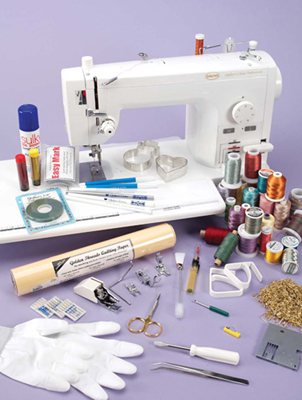
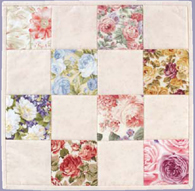
With stitch-in-the-ditch, the pieced fabric is emphasized with minimal surface texture.
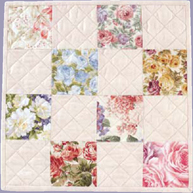
Straight-line quilting adds a strong geometric texture.
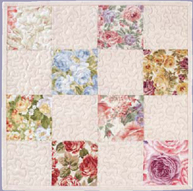
Meandering blends all of the fabrics together and creates a graceful texture to the fabric surface.
In its simplest form, quilting is the sewing that holds the three quilt layers together: the quilt top, the batting and the backing. In its most complex form, quilting is the art of using thread and pattern to breathe life into the quilt surface. In this book, I will show you the techniques you need to become a quilter; from the practical to the artistic and everything in between.
Frequently Used Terms
Before we begin, review the following list of terms or phrases used frequently throughout the book.
All-over quilting pattern
A pattern used over a large area of a quilt or an entire quilt surface.
Binding
A narrow, folded strip of coordinating fabric that finishes the outer edges of a quilt. Adding the binding is the last step of a project, after the quilting is done.
Echo quilting
A line of quilting that traces an existing motif. Echo quilting can trace existing quilting, a piece in a block, an appliqu or an embroidery design.
Fat quarter
A piece of fabric measuring 18 21. When cutting yard of fabric from selvage to selvage, the cut is 9 wide. A fat quarter comes from a half-yard cut of fabric with an additional cut at the fold of the fabric.
Finished size
The size of a block or portion of a quilt after all the piecing has been completed.
Free-motion quilting
Popular quilting method in which the quilter disengages the feed dogs and moves the quilt sandwich in a random or marked sequence.
Fussy-cut
A fabric cutting technique that carefully cuts novelty print fabric. The cutting centers an image in a square of fabric.
Grain
Straight grain parallel to selvage Cross grain selvage to selvage
Pin-basting
Securing the quilt layers prior to quilting with quality safety pins.
Quilt sandwich
A layer of backing fabric, a layer of batting and the quilt top which have been basted together to form a single unit.
Straight-line quilting
A quilting technique using a walking foot to feed the quilt sandwich through the machine as a single unit. A walking foot does not lend itself to curved quilting lines.
Strip
A single strip of fabric cut on the cross grain of the fabric (selvage edge to selvage edge).
Strip set
The piece created by sewing two or more strips together.
Tools
The Sewing Machine
